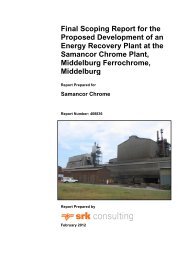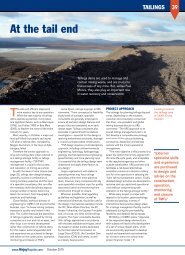Draft Status Quo Report for the Pixley Ka Seme ... - SRK Consulting
Draft Status Quo Report for the Pixley Ka Seme ... - SRK Consulting
Draft Status Quo Report for the Pixley Ka Seme ... - SRK Consulting
You also want an ePaper? Increase the reach of your titles
YUMPU automatically turns print PDFs into web optimized ePapers that Google loves.
<strong>SRK</strong> <strong>Consulting</strong> in association with BKS<br />
<strong>Pixley</strong> <strong>Ka</strong> <strong>Seme</strong> Local Municipality EMF – <strong>Draft</strong> <strong>Status</strong> <strong>Quo</strong> <strong>Report</strong> Page 14<br />
2 Approach and<br />
methodology<br />
The approach adopted <strong>for</strong> this EMF is one based on a<br />
broad conception of sustainable development as<br />
embodied within South Africa’s Constitution, policy<br />
and legislative framework, and recently rein<strong>for</strong>ced by<br />
<strong>the</strong> National Framework <strong>for</strong> Sustainable Development<br />
(NFSD) (DEAT, 2006). This was adopted by Cabinet in<br />
July 2008. The section that follows defines <strong>the</strong> concepts<br />
of sustainable development, focusing on EMFs as a tool<br />
<strong>for</strong> promoting sustainable decision-making. It also<br />
outlines <strong>the</strong> EMF process indicating where <strong>the</strong> status<br />
quo assessment fits into <strong>the</strong> process.<br />
2.1 Sustainable development<br />
NEMA defines sustainable development as “<strong>the</strong><br />
integration of social, economic and environmental 1<br />
factors into planning, implementation and decisionmaking<br />
so as to ensure that development serves present<br />
and future generations”.<br />
Sustainable development recognises <strong>the</strong><br />
interdependencies between <strong>the</strong> natural environment,<br />
economic stability and social well-being. South Africa’s<br />
draft NFSD (DEAT, 2006a) adopts an embedded model<br />
of sustainability that sets socio-economic development<br />
within its environmental resource base, with <strong>the</strong><br />
relationships between <strong>the</strong> components underpinned and<br />
regulated by a governance framework (see Figure 2-1).<br />
Ecosystem<br />
integrity<br />
People’s<br />
well-being<br />
Society<br />
Economic<br />
viability<br />
2.2 EMF – a tool <strong>for</strong> sustainable<br />
management<br />
A range of environmental tools, including <strong>the</strong> EMF,<br />
assist in integrating “social, economic and<br />
environmental factors into planning and decision<br />
making in order to ensure that development serves<br />
present and future generations” (NEMA, 1998).<br />
The EMF is a management and decision support tool<br />
that provides authorities with in<strong>for</strong>mation about <strong>the</strong><br />
‘state of environment’ and <strong>the</strong> planning parameters. Its<br />
purpose is to identify and spatially represent areas of<br />
potential conflict between sensitive environments and<br />
development proposals <strong>the</strong>reof. Using a Geographic<br />
In<strong>for</strong>mation System (GIS) plat<strong>for</strong>m, <strong>the</strong> EMF enables<br />
its application at various scales. The final stage in <strong>the</strong><br />
development of <strong>the</strong> EMF is <strong>the</strong> integration of base data<br />
sets into a single facet coverage depicting and spatially<br />
delineating <strong>the</strong> potential environmental sensitivity of<br />
<strong>the</strong> area. This in turn <strong>for</strong>ms <strong>the</strong> basis <strong>for</strong> a holistic<br />
environmental development framework that guides<br />
development and conservation priorities.<br />
These elements are incorporated in <strong>the</strong> EMF<br />
methodology presented in Section 2.3.<br />
2.3 Project phasing<br />
In<strong>for</strong>med by <strong>the</strong> Guideline Document <strong>for</strong> EMF (DEAT,<br />
2005), <strong>the</strong> process of developing <strong>the</strong> PKSLM EMF has<br />
been phased as described below.<br />
2.3.1 Project inception (Phase 1)<br />
The inception phase of <strong>the</strong> project was principally<br />
involved in setting up a Project Steering Committee<br />
(PSC), clarifying project scope and communication<br />
strategy, collecting available and up-to-date literature<br />
and spatial data, undertaking site visits and<br />
commissioning specialist investigation.<br />
Good Governance<br />
Figure 2-1: An integrated conceptual model of<br />
sustainable development<br />
Source: DEAT (2006)<br />
1<br />
In this paper, <strong>the</strong> term ‘environmental’ refers to biophysical<br />
components.<br />
2.3.2 <strong>Status</strong> quo assessment (Phase 2)<br />
The draft environmental <strong>Status</strong> <strong>Quo</strong> report defines and<br />
spatially represents <strong>the</strong> current state of <strong>the</strong> environment<br />
of <strong>the</strong> local municipality’s environment, as derived<br />
from <strong>the</strong> literature review, specialist studies and<br />
stakeholder consultation. This will be Volume 1 of <strong>the</strong><br />
EMF process deliverables. As part of <strong>the</strong> status quo<br />
KILI/BEAT G:\404946_PIXLEY EMF\7REPORTS\<strong>Status</strong> <strong>Quo</strong> report\<strong>Draft</strong> report\<strong>Draft</strong> status quo report, July 2010.docx July 2010









